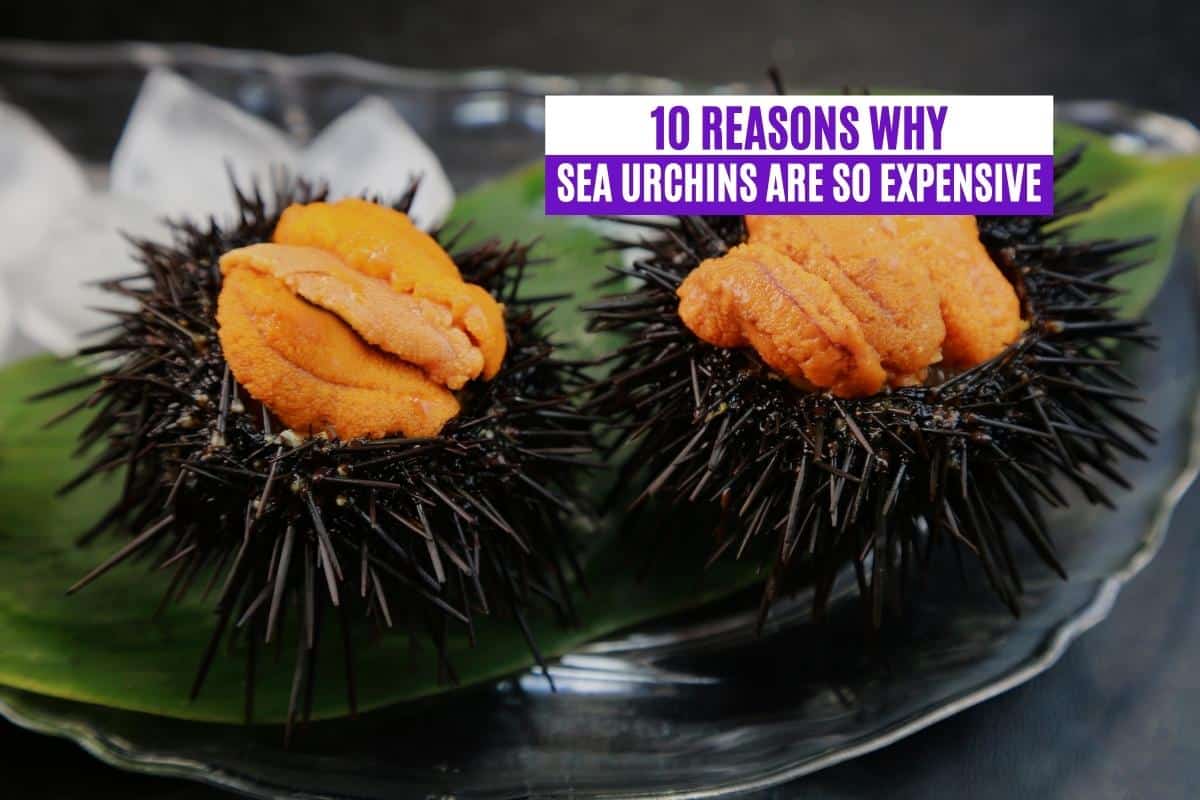Sea urchins might look like spiky, spiny balls, but their protective exoskeletons hide soft and edible gonads (called uni). These bright yellow (and sometimes orange) bits are a prized ingredient in luxurious seafood restaurants, but they’re not cheap. Still, why are sea urchins so expensive?
Sea urchins are expensive because they’re in low supply, but they’re a prized delicacy, making demand high. Additionally, sea urchin gonads are best when harvested during the non-spawning season, so diners must wait for specific times of the year to enjoy creamy, high-quality sea urchin pieces.
This guide will explore how much sea urchins cost and discuss why these echinoderms are so expensive. If you’re curious to try this exquisite seafood for yourself, be sure to review the information below.
How Much Does Sea Urchin Cost?
Sea urchin prices vary depending on your location. For example, those living near coastal areas often pay slightly less for sea urchins than those living in landlocked regions.
That said, sea urchins are primarily harvested from cold deep waters like those found off the coast of:
- Maine
- British Columbia
- Chile
- The Hokkaido Prefecture
- Jeju Island
Consequently, those living in sub-tropical or tropical coastal areas might also pay a high price to acquire a few fresh sea urchins.
Sea urchins typically cost about $1.50 per pound and between $16 and $30 per specimen. This type of seafood is often served in halves (with the spiny exoskeleton intact).
The average diner can expect to spend about $10 per homecooked sea urchin and $20 or more for a sea urchin prepared at a restaurant.
Here’re the Top 10 Reasons Why Sea Urchins Are So Expensive:
- Sea urchin is a delicacy
- Sea urchins taste best during specific seasons
- Supply is low and demand is high
- Sea urchins live in deep waters
- Not all species are edible
- Sea urchins can be poisonous
- Preparing sea urchins is challenging
- Only the gonads are edible
- The taste of sea urchin is unique
- Fresh sea urchin tastes best
10. Fresh Sea Urchin Tastes Best
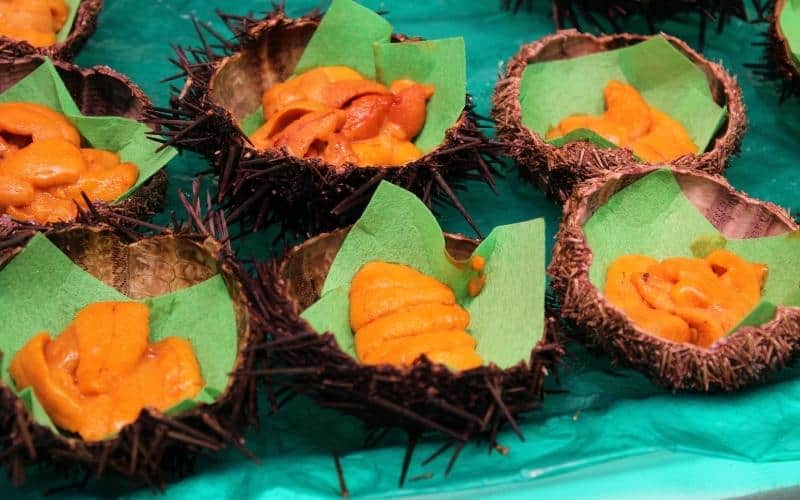
Transporting raw seafood can be challenging, no matter the species. After all, once sea creatures are removed from their natural habitat, keeping them alive and stress-free can be almost impossible.
Unfortunately, saltwater tanks and calm environments aren’t always available, so some fish and crustaceans quickly spoil after harvest. This concept also applies to sea urchins.
For this reason, some sea urchin retailers prefer to freeze or chemically process their uni supply. These practices keep the sea urchin from rotting, but they can also negatively affect the taste.
While flash freezing is one of the best ways to maintain the original taste of sea urchin, prolonged shipping times and varying temperatures can significantly harm the quality of frozen uni.
Diners who are determined to enjoy the best sea urchin are often willing to travel to international destinations to experience the taste of fresh-caught, recently prepared uni. Naturally, this can add several thousand dollars to the overall cost of trying sea urchin.
The Bottom Line
Frozen or processed sea urchin loses much of its original flavor, so seafood lovers are typically willing to pay more for the chance to experience freshly harvested uni.
9. The Taste of Sea Urchin Is Unique
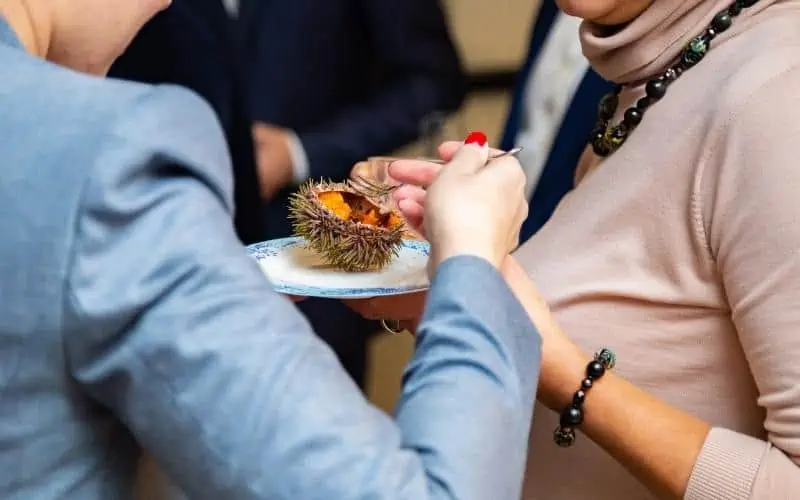
Foods with distinct and unique flavors often cost more than foods with familiar flavor profiles. For example, many of the world’s most expensive sushi pieces feature outstanding price tags due to their unreplicable tastes.
Sea urchin is an excellent example of seafood with a remarkably distinct flavor profile and texture. Uni (sea urchin gonads) are often custard-like, with a salty taste and creamy consistency.
These traits set sea urchins apart from other seafood delicacies like bluefin tuna or Coffin Bay oysters. They also make them comparatively expensive, as many people are willing to pay a high price for the chance to experience high-quality uni.
The Bottom Line
Nothing tastes exactly like uni, making it a unique dish that attracts individuals with refined palates and a curiosity about the world’s most expensive seafood.
8. Only the Gonads Are Edible
Unlike terrestrial creatures, many of which feature multiple edible parts, the only edible part of a sea urchin is its gonads. These yellow oblong portions are relatively small compared to the sea urchin’s total size.
So, when you buy a whole sea urchin, you’re mostly spending your money on this tiny portion. The rest of the creature (the spiny exterior and guts) are all wasted, as they’re inedible.
Imagine raising a cow but only being able to eat the striploin, one of the most minor and most expensive steak cuts. You’d find that the cost to raise such a large animal, only to harvest a minimal portion, drives up the price of the meat.
The same concept applies to sea urchins, making them an expensive delicacy.
The Bottom Line
The spiny exterior and internal guts of the sea urchin are inedible. Only the yellow gonads are edible, and they comprise only a tiny percentage of the entire creature, increasing the price-per-pound for sea urchins.
7. Preparing Sea Urchins Is Challenging
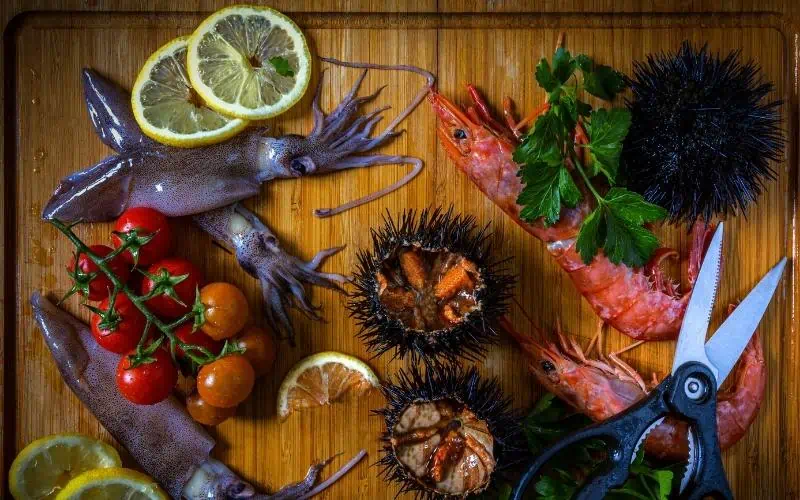
Cutting open a fish, gutting it, and fileting the tender meat is far easier than preparing a sea urchin. That’s because sea urchins are spiky balls full of poison.
Much like pufferfish (fugu), it takes a skilled hand and years of culinary expertise to prepare sea urchins safely. As such, many chefs refuse to prepare sea urchins.
The remaining brave handful can charge premium prices based on their experience and expert-level preparation skills.
The Bottom Line
Sea urchins are covered in poisonous spines. Cutting them open and removing their guts is time-consuming, so many chefs charge higher prices for uni dishes.
6. Sea Urchins Can Be Poisonous
The thick spines covering a sea urchin can prick your skin and cause you to bleed. But many sea urchin spines also contain dangerous venom, which acts as a defense mechanism in the wild.
Touching the spines of a live sea urchin (or one that’s improperly prepared) has several potential consequences. Contact with sea urchin poison can lead to skin necrosis, paralysis, and death.
As such, chefs must take exceptional care when handling and preparing sea urchins for diners. This extra level of caution and safety typically translates to a higher price.
The Bottom Line
Sea urchin spines can be poisonous, as can the internal pedicellariae (small valves). Therefore, chefs must be careful when handling and preparing sea urchins. These safety precautions can increase the cost of sea urchin dishes.
5. Not All Species Are Edible
Did you know that there are about 950 types of sea urchins? Did you also know that only about 18 of these species are edible?
This low number of edible species makes harvesting, preparing, and serving uni incredibly complicated. In addition, the scarcity of edible sea urchins makes it challenging for anglers to harvest desirable species.
The Bottom Line
Though there are more than 900 sea urchin species, less than 20 are edible. This exclusivity makes finding and harvesting edible sea urchins more challenging, making meal-ready uni inherently more expensive.
4. Sea Urchins Live in Deep Waters
While sea urchins are occasionally found in tidal areas close to the shore, they can also live up to 15,000 feet beneath the water’s surface. This depth puts them beneath the continental shelf line, which is deeper than the average ocean depth of about 12,400 feet.
For this reason, commercial anglers often need specialized deep-sea harvesting equipment to obtain sea urchins. Overfishing practices have made this even more necessary, as tidal species are all but wiped out in most areas of the world.
The labor and equipment required to harvest sea urchins increase the overall cost of uni.
The Bottom Line
The labor required to find and harvest sea urchins is much higher than the labor needed to harvest farmed fish or coastal seafood species. These high labor costs contribute to the high price tags associated with sea urchins.
3. Supply Is Low and Demand Is High
The number of harvested sea urchins has steadily decreased over several decades. This lower yield most likely stems from overfishing, as companies are determined to earn higher profits each season.
The more sea urchins harvested, the fewer specimens left to produce more each year. Making matters worse is the increasingly high demand for uni.
While sea urchin’s culinary popularity was once restricted to Asia, the rapid spread of information and international cuisine has made it a worldwide delicacy. As such, diners looking to enjoy a luxurious seafood experience are demanding uni now more than ever before.
This relationship between supply and demand raises the price for sea urchins. Unless the demand decreases, the price for this seafood will only increase with time.
The Bottom Line
The sea urchin is often overfished due to the high demand for its delicate and tasty gonads. Consequently, supply consistently dwindles while demand continues to rise, increasing prices.
2. Sea Urchins Taste Best During Specific Seasons
Sea urchin gonads don’t retain their creamy texture and delicate saltiness forever. Instead, these internal organs become firm and gritty when sea urchins near and enter the spawning period.
Spawning periods vary depending on location. For example, sea urchins off the coast of Maine typically spawn in the spring and summer. But specimens located off the coastlines of Japan may reproduce during the autumn.
While you might assume this makes high-quality uni available all year round, it restricts sea urchin availability and freshness. Those wanting to enjoy uni during the summer season might need to travel to Japan or South Korea to do so, while those looking for top-notch uni in winter might need to visit Maine or Canada.
The Bottom Line
Sea urchin gonads have the best flavor and texture when harvested before the spawning period. This restriction makes uni a seasonal delicacy, thus driving up demand and price.
1. Sea Urchin Is a Delicacy
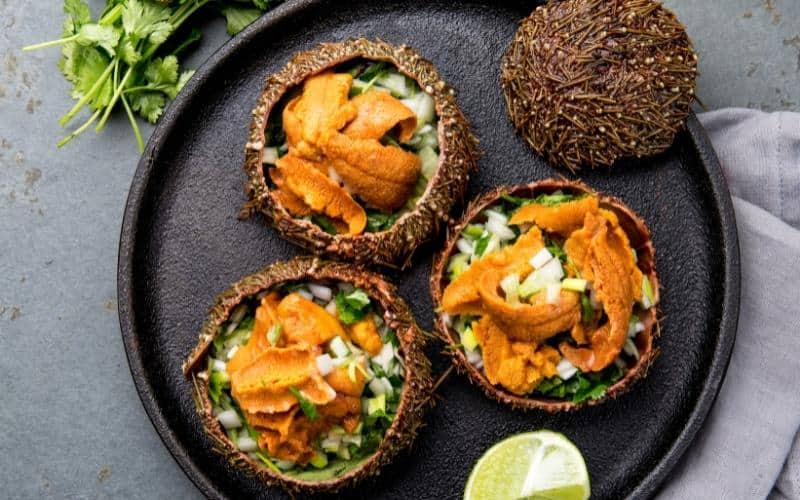
If you ever visit a top-rated seafood restaurant or sushi bar, there’s a good chance you’ll see uni listed on the menu. That’s because sea urchin is considered one of the finest ingredients throughout much of the world.
But the Japanese might revere sea urchin more than other peoples. This praise partially stems from a long history of seafood-based culinary practices, but traditional medicine also comes into play.
Sea urchins are commonly believed to be an aphrodisiac. While there’s little scientific evidence to support this belief, the underlying logic isn’t challenging to understand.
After all, uni is the gonads of sea urchins. They’re the sexual organs responsible for sea urchin reproduction. And when harvested at the right time, these golden bits have a creamy, salty flavor.
These aspects are associated with human sexuality, fertility, and vitality. As a result, people have eaten sea urchins to boost their sexual prowess, possibly since ancient times.
The Bottom Line
Sea urchin is one of the most prized seafood items in fine dining restaurants, driving up its price and marking it as a delicacy. Its reputation as an aphrodisiac also increases its price.
What Does Sea Urchin Taste Like?
Sea urchin gonads (more commonly called uni) are often described as having a melt-in-your-mouth texture. They’re creamy, soft, and salty. However, these descriptors only apply to pre-spawn uni.
When sea urchins enter the spawning period, their gonads develop a thicker and firmer texture that’s far less texturally pleasing. This type of uni can be gritty and leave a metallic taste in your mouth.
Fortunately, most sea urchins served in fine restaurants are harvested before entering the spawning period. But if you’re planning on buying whole sea urchins to prepare and serve at home, you’ll want to ensure you’re choosing a reputable purveyor.
Otherwise, you could end up with uni that’s tough and far less palatable than the delicate, buttery uni served at the world’s finest restaurants.
Why Is the Taste Worth the Price?
Uni has an entirely unique umami taste. Because it’s impossible to replicate the soft texture and specific taste of sea urchin gonads, diners are willing to pay a high price for the chance to taste this delicacy.
Essentially, the taste is worth the price due to its distinctness and rarity. Diners with a penchant for eating only the finest meals won’t want to miss the opportunity to enjoy a perfectly prepared sea urchin.
Why Is Sea Urchin Expensive?
Sea urchins are some of the most expensive seafood items, with an average price tag of about $16 to $30 per specimen. There are several reasons why sea urchins command such high prices.
For example, sea urchin is considered a delicacy, so it’s almost always in high demand. But edible sea urchin species are limited, and this seafood tastes best during specific times of the year.
To learn more about the most expensive foods and beverages, be sure to read these related articles now!

